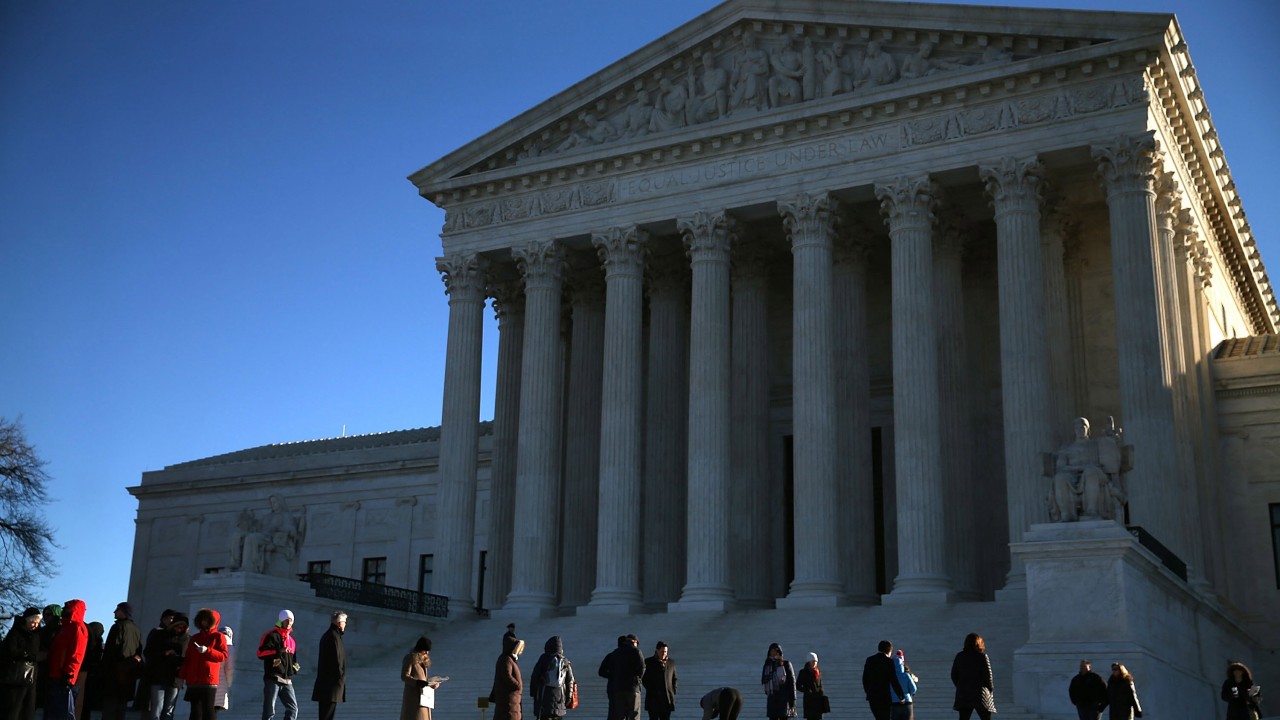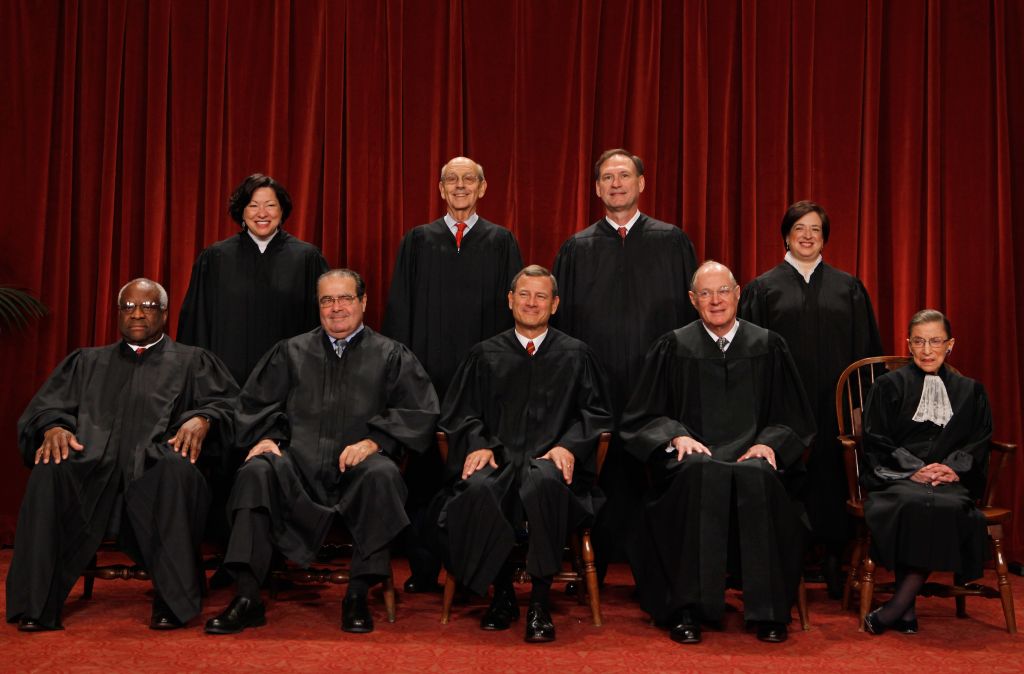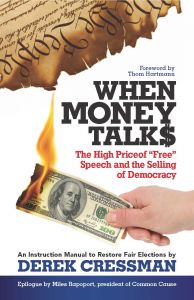
A court that's normally divided along ideological lines came together on a bedrock principle of voting rights. (Photo by Mark Wilson/Getty Images)
The following is excerpted from veteran campaign finance reformer Derek Cressman’s new book, When Money Talks: The High Price of “Free” Speech and the Selling of Democracy.
— English proverb
The first stage in repairing our Constitution from the damage of Buckley and Citizens United is for the American people to rouse ourselves out of the slumber of normal politics and enter a phase of extraordinary political engagement. Once we have corrected the structural flaws big money has wrought, we’ll be able to get back to our private lives.
This first step — raising awareness — is the most time-consuming part of the amendment process. Thankfully, we are fairly well into this stage. Due in part to campaign disclosure laws, the media’s muckraking, and follow-the-money groups that regularly churn out data linking campaign donations to particular issues, the American public is thoroughly aware that big money in politics is a problem. That awareness has bred disgust and cynicism, but it is only now reaching a point of anger and action.
What has been missing over the past 40 years was an understanding that the US Supreme Court intentionally created this problem — and that there is a solution to that problem, namely reversing the Court with a constitutional amendment.
Next Steps
Before it succeeds, the amendment movement will enter a stage where it finds majority support in both houses of Congress but not the two-thirds necessary to send an amendment to the states to ratify. It has already reached that stage in the US Senate. This stage will be similar to the 1890–1911 period during the movement to win direct election of senators, when there was supermajority support among the public and two-thirds support in the House but not in the Senate. Here are seven steps reformers could take to convert supermajority public support into sufficient legislative support.

US Supreme Court members (first row L-R) Associate Justice Clarence Thomas, Associate Justice Antonin Scalia, Chief Justice John Roberts, Associate Justice Anthony Kennedy, Associate Justice Ruth Bader Ginsburg, (back row L-R) Associate Justice Sonia Sotomayor, Associate Justice Stephen Breyer, Associate Justice Samuel Alito and Associate Justice Elena Kagan pose for photographs in the East Conference Room at the Supreme Court building October 8, 2010 in Washington, DC. (Photo by Chip Somodevilla/Getty Images)
Step 1: A Confirmation Battle Royale
The next president will likely have the opportunity to replace at least one Supreme Court member who opposed Citizens United (perhaps Ruth Bader Ginsburg) and two members who supported it (possibly Anthony Kennedy and Antonin Scalia). If two out of those three new members oppose the Citizens United ruling, and if a new case is presented to the court before the vote count flips back, the Court could reverse Citizens United on its own. The confirmation process alone could turn into a national debate about big money in politics. Americans should demand that senators ask Court nominees whether they think unlimited spending is the same thing as free speech and oppose confirmation of any nominee who provides a squishy answer. Voters could also question candidates for the Senate to see if they would apply this litmus test to court nominees.
Step 2: A National Voter Instruction
Citizens in Alaska, Arkansas, and Washington state may follow the lead of Colorado and Montana and hold statewide votes to instruct their congressional delegation to use all possible means to overturn the Citizens United ruling, including a constitutional amendment. Other states may join the effort — but many states do not have a process by which citizens can place an instruction question on the ballot.
So why not do it nationally? Unlike in California and other states, there is no national right to instruct members of Congress, nor is there a national initiative process where voters can place questions on the ballot. But nothing prohibits Congress from placing a voter instruction measure on the national ballot just as Chicago, Los Angeles, San Francisco, and other localities have done. Reformers could take this step with majority support that falls short of the two-thirds needed to formally move an amendment out of Congress.
Although we have never had a national instructions vote, the idea has been proposed before. Senator William Stone introduced a bill for a national voter instruction measure in 1916 to ascertain the people’s wishes about entering World War I. In 1939, the House actually voted on a similar proposal by Wisconsin senator Bob La Follette regarding World War II, defeating it by vote of 73 to 17.
It’s unclear if Congress could force state election officials to place a federal instruction question on state ballots. If a state refused, Congress could direct the Election Assistance Commission or another federal agency to administer the instruction election using a separate vote-by-mail ballot.
Step 3: Defy the Roberts Court
Either a federal instruction measure or a state ballot initiative could combine a voter instruction with a statute that defies the Supreme Court’s edict that money is speech — for instance by setting limits on contributions to super PACs or on candidate campaign spending. That would set the stage either for a court reversal or a constitutional crisis if the executive branch chose to enforce the law despite the Supreme Court’s contrary opinion.
In 2012, Representative John Dingell introduced a defiance bill called the Restoring Confidence in Our Democracy Act that reenacted the policies that the Roberts Court struck down in Citizens United. Congress could pass a similar bill by majority vote.
John Roberts does not want to go down in history as the chief justice who baited Congress to ignore him and permanently weaken the Supreme Court as an institution. He also doesn’t want to find out what would happen if a president refused to send in troops to enforce his Court’s unjust order against a state law limiting money in politics.
Reformers will win if John Roberts concludes now what Owen Roberts concluded in 1937 when he made the “switch in time that saved nine” (described in chapter 5) — that the only way to preserve his institution’s power and his place in history is to reverse his wrongheaded ruling.
Step 4: A New Electoral Strategy for Uniform Accountability
In 2014, Harvard professor Larry Lessig formed a project called the Mayday PAC, which spent more than $10 million in 10 targeted races around the country trying to elect reformers and defeat anti-reform incumbents. While the effort no doubt influenced some voters, it neither persuaded enough of them to prioritize reform as an issue, nor inspired many new people to enter the electorate.
One factor that thwarted Mayday PAC was that incumbent political machines moved big money into the ten targeted races in order to offset Mayday’s spending. Some critics questioned the choice of targets as well.
Rather than targeting a handful of races, reformers could apply uniform criteria to all races and issue a scorecard to every incumbent and a corresponding pledge to every challenger on whether they would support a constitutional amendment to reverse Citizens United. Moving a small number of voters to prioritize this issue in every district might be easier than getting a larger number to prioritize the issue in a small number of districts.
With low-turnout elections where very few voters change their minds, changing just a few votes in a district that was not targeted could yield surprising results. This strategy could work particularly well in primary elections, just as the Tea Party has demonstrated success in unseating incumbents who have not addressed their priorities and concerns. An electoral campaign would work even better if there has been a national instructions measure to which every incumbent can be held accountable.
Step 5: Changing the Process State by State
One of the key factors in winning direct election of senators and women’s suffrage was the ability of reformers to change the rules at the state level. Members of Congress from those states then had no reason to fear new federal rules because they were already playing under similar state rules.
The 1974 Federal Election Campaign Act (FECA) preempted states from setting their own contribution limits for congressional elections. Courts have ruled that this same preemption prevents states from offering public financing to federal candidates. But this part of FECA could be repealed.
Reformers who had a simple majority, but not two-thirds, could abandon a uniform federal approach and go back to letting states set rules for their own congressional races. We might then see several states sending members to Congress who could only accept small contributions rather than the current federal limit of $2,700. Especially if those states matched small contributions with public funds, some grassroots candidates would be able to beat big money candidates backed by the super PACs.
Even without a repeal of FECA, states could implement digital voter guides that provide every candidate an opportunity to communicate with voters at no cost to their campaign through a series of online videos. California and other states already provide voters with printed guides to candidates for federal office, which does not conflict with federal campaign finance rules.
Step 6: Forcing a Crisis with a Convention of the States
A grassroots group called Wolf PAC is leading efforts to have legislatures apply for a convention of the states to draft an amendment if Congress refuses to do so. They have had impressive success, with Vermont, California, Illinois, and New Jersey making formal applications for a convention and other states seriously considering it.
Several questions about how a convention would work have hindered this approach, including:
- Who will be the delegates to the convention?
- What will the rules be for the convention?
- Will it be confined to proposing amendments only on one topic, or can delegates propose multiple amendments about anything they want?
A significant push for a convention of states to propose a balanced-budget amendment has demonstrated the power of this approach, but it has also raised concerns. Since the 1980s, some twenty-seven states have applied for a convention to draft a balanced-budget amendment, and that momentum (combined with Ross Perot’s presidential run) pressured a Republican Congress and President Bill Clinton to enact several balanced budgets in the 1990s. States are renewing these efforts, leading those who worry about the damage a balanced budget could do during times of war or recession to oppose any constitutional convention for fear it could produce a balanced-budget amendment in addition to other amendments.
Congress could resolve such questions, again by majority vote, and pass rules by which a convention of state delegates would operate. But Congress has refused to do this because it does not want to encourage a convention of states around any issue. Nonetheless, if a simple majority in Congress was really serious about an amendment to limit big money in politics, it could take this step.
An alternative would be for the states calling for a convention to pass what’s known as an interstate compact that would set the rules for the convention to operate. Interstate compacts are routine procedures that often deal with issues such as regional transit authorities or bodies of water that cross state lines.
There is a growing movement to change the way states appoint their representatives to the Electoral College through an interstate compact that would in effect institute a national popular vote for presidential elections. Interstate compacts are guaranteed in the Constitution and enforceable in court.
A state’s compact for a convention could specify who delegates would be — perhaps the Speaker of each house from a state’s legislature as well as the leaders of the majority and minority parties. It could include a provision to immediately recall a state’s delegates if any member of the convention proposed an amendment that was beyond the scope that had been authorized by the state applications. In that way, legislatures could prevent the convention from going off topic by denying it a quorum.
Most likely, as with the Seventeenth Amendment, Congress would act once the number of states calling for a convention approached the number needed to actually convene one. But if Congress still stonewalled, the states’ convention could propose an amendment that would still require ratification of 38 state legislatures.
That ratification requirement, along with an interstate compact or congressional rules outlining precisely how the convention would operate, would eliminate concerns about a runaway convention proposing amendments a supermajority of voters do not want.
Step 7: Nonviolent Protest
Supreme Court rulings are not set in stone. They are not brought down from the mountaintop by Moses, John Roberts, or anyone else. They are not always right.
As a government becomes more tyrannical, it closes off formal processes for change and dissent. Judges ignore state constitutions in order to cancel voter instruction elections aimed at refuting other judges, for instance.
Too often, reformers confine their imagination to the narrow box of prescribed rules for passing policy rather than stepping back to the inherent and inalienable rights set forth in our Declaration of Independence. When we find our formal process for governing ourselves is broken, we can do what people the world over have done to overthrow corrupt and oligarchic regimes.
We can take to the streets.
Our predicament is less dire than what workers in Poland’s Solidarity movement faced in the 1980s, or what blacks living under South Africa’s apartheid regime endured for almost 50 years. Pro-democracy activists in Egypt did not change their constitution by following the rules outlined by Hosni Mubarak; they ousted him with protests in Tahrir Square. If they can prevail, so can we.
Nonviolent direct action has deep roots in the United States. Although polite advocacy played an important role in winning the right to vote for women, suffrage was pushed over the brink when the “iron-jawed angels” refused to be force-fed. Their hunger strike spoke louder than words when the government imprisoned them for their political speech.
Our Supreme Court tries to project power, but it does not command any army and lately does not command much public respect. The 320 million residents who are not on the Supreme Court can easily defeat the five recalcitrant ideologues who control the Court.
Just such a popular protest movement is already afoot.
One year after Kai Newkirk was arrested for speaking his mind in the US Supreme Court, seven more people were jailed for doing the same thing. Four months later, on the one-year anniversary of the McCutcheon v. FEC ruling, five more members of 99Rise were arrested for protesting inside the Supreme Court despite escalating threats of prosecution.
On April 15, 2015, Florida mailman Doug Hughes risked his life by flying his gyrocopter through restricted airspace to land on the lawn of the US Capitol. Hughes was arrested before he could deliver his 535 letters to members of Congress demanding that they overturn the Citizens United ruling. More such protests — equally disruptive, equally creative — are sure to follow.
The jails cannot hold 320 million people. What will they do when they run out of space?
Why It Is Easier to Accomplish a More Daunting Task
Pundits who are closer to the mechanics of passing legislation than they are to the desires of the people think it is easier to pass a modest reform statute than a sweeping constitutional amendment. After all, it takes 67 votes in the US Senate to propose an amendment compared to only 60 votes to break a filibuster and pass legislation.
But, is there a scenario where it is easier to get to 67 than it is to get to 60? Only if the proposal that needs 67 votes musters significantly more public support than the incremental proposal — and this is the situation we find ourselves in with a constitutional amendment to get big money out of politics.
Joe Biden, in explaining his support for an amendment in addition to incremental reforms, noted that “moderate reform is like moderate chastity.” It is difficult to persuade citizens to devote the time and energy needed to win any reform if it doesn’t seem as if it will make much of a difference. Likewise, voters will prioritize other issues instead of money in politics when casting their ballots if the differences between candidates are only a matter of degree or if every candidate can claim to be “anticorruption” but not held to any simple yet specific standard of what that means. And of course, no protester will risk arrest, let alone being shot out of the sky, just to pass a minor disclosure provision in wonky campaign finance law.
To reach either 67 or 60 votes in the US Senate, reformers will need support from both Republican and Democratic legislators. It may actually be easier to get 15 or 20 members of a political party to support a simple and popular amendment all together than it would be to get only four or five to break ranks over an obscure incremental measure that the public does not understand.
Along the way to an amendment, reform opponents will try to ventilate public pressure by offering partial solutions.
That’s good, because pressure for a real solution won’t go away, and we are more likely to win incremental victories by thinking big than by using incremental measures as a starting point for negotiations.
Reform Springs Eternal
When I first began working on money in politics in the mid-1990s, I figured we’d “solve” our problems in five to 10 years and then I could go on to other things.
Like most reformers, I was drawn to the issue because I saw how big money had influenced and corrupted issues that had a direct impact on my life. When I realized it might take more than five to 10 years, I drew up a 20-year plan. But regardless of the timeline, it was important to me that there was a goal in sight, some time when the work would be done.
Five years into my work, my outlook changed. I found myself in Siena, Italy, inside one of the oldest city halls in existence. The people who had lived there formed city-states that operated as democracies hundreds of years before the American Revolution. Our Founders drew inspiration and experience from those Italian city-states.
Inside the 700-year-old city hall of Siena there is an extensive set of murals depicting good government and bad government. In the bad government painting, corruption flourishes, while famine and plague sweep the countryside.
While viewing the mural, I realized that reforming government is not a finite project. Reform will never be completed but is rather an ongoing process that every generation must undertake. We form a government only to see it change its form. We then must form it again — reform springs eternal.
It can be depressing to realize that we will never permanently arrive at “good” government and will instead forever strive for “better” government than we currently have. But, this realization is also encouraging. Even if our work is never done, we know that things can and will get either better or worse depending upon our own actions.
Doctors know that eventually every patient they treat will die, but the quality and length of their life can often be improved by diligent medical care, or shortened by neglect. Likewise, citizens must accept that there will be continual threats to our democratic republic, but with diligence and commitment we can make things better.
If we don’t act, we can also be assured that things will get worse.
It is up to us.
Excerpted from When Money Talks: The High Price of “Free” Speech and the Selling of Democracy by Derek Cressman, on sale now from Berrett-Koehler Publishers.





